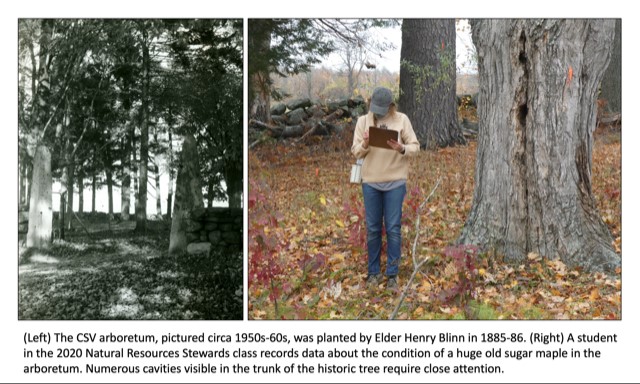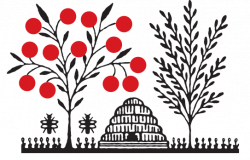Canterbury Shaker Village Arboretum Inventory

Canterbury Shaker Village Arboretum Inventory
By Jennifer J. Montgomery, November 2020
The Canterbury Shakers emphasized knowledge, innovation, and appreciation of the natural world in nearly everything they did. The CSV arboretum, a ‘garden’ of trees, remains a testament to the Shaker spirit to this very day.
Located slightly northwest of the Village schoolhouse, the arboretum was initiated by luminary Elder Henry Blinn as New Hampshire’s first-ever arboretum in 1885-1886. One of its primary purposes was to provide to schoolchildren at the Village an opportunity to study native trees crucial to New Hampshire and to the work and commerce of the Village.
A 2013 report prepared by The Urban Forestry Center of New Hampshire’s Division of Forests and Lands describes the educational purposes of the arboretum. It also notes how Elder Blinn provided to the schoolchildren a collection of labeled wood samples so that they could gain familiarity with the wood grain and properties of trees at the Village. This type of practical knowledge would have been central to the Shakers’ careful efforts both to use and conserve natural resources located on their acreage.
Eldress Bertha Lindsay in 1976 wrote in “The Trees on Canterbury” that “the Grove [i.e. the arboretum] consisted of one of every kind of shade or forest tree grown on our property. It was situated behind the schoolhouse. The hurricane of 1938 levelled a beautiful Tamarack tree, others have died or been cut down for various reasons. This spot provided wonderful shade for picknickers for years, and one we hope to renew in memory of one [Elder Henry Blinn] who added so much beauty to our home…”
Trees that remain in the arboretum today include white pine, red pine, hemlock, white ash, red oak, white oak, basswood, paper birch, sugar maple, red maple, and hop hornbeam. Age and the elements have taken their toll. For example, high winds last fall resulted in the cracking off of the top third of one of the tallest white pines. But volunteers over the years have worked to preserve the arboretum.
Students in the 2020 Natural Resources Stewards class (NRS), which met at the Village for 12 weeks this fall, recently worked with their instructors to complete an inventory of the arboretum. Led by NRS leaders from UNH Cooperative Extension and New Hampshire’s Urban Forestry Center, students identified each remaining tree, measured its trunk and canopy, and assessed the condition of each tree.
J.B. Cullen, a longtime New Hampshire forester and one of the NRS leaders, said that inventories are a crucial first step in planning for the long-term health and maintenance of trees like those found in the arboretum. He said an inventory also helps understand the value of ecosystem services the trees provide.
Another crucial inventory element, according to Cullen, lies in understanding the basis for the implementation of a future management plan. Gaining clarity on the current purpose of the arboretum and its management provides a good foundation for decision-making. For example, should a management plan prioritize the historical value of the arboretum? Or perhaps the educational purpose or perhaps a full restoration? Answers to those kinds of questions help set priorities for the best possible management and maintenance decisions.
During their NRS course, students studying the Village landscape and resources learn about the push-pull of potentially competing priorities. For example, a tree might be showing its age in terms of splits or other adverse conditions, but it might have a historical importance that warrants preservation measures in spite of substantial problems.
Cullen led the NRS students in collecting comprehensive data about the trees in the CSV arboretum. This included tree species, including the Latin names; the diameter of trees; the location of each tree; and the overall condition. Planners at the Village will be able to use this data to create a long-term management plan in support of the purposes they assign to the arboretum in current times.
The volunteer contributions of the 2020 NRS class are part of a long history of attending to the Village arboretum. Village archives contain various documents with references to “the Grove.” For example, the Urban Forestry Center report of 2013 notes that “the large chestnut tree was lost years ago due to the Chestnut Blight. Other large trees were also lost in the Hurricane of 1938.”
And The Shaker Quarterly from the summer of 1971 (Vol. 11, no. 2) includes ‘Home Notes from Canterbury’ that document plantings in memory of Eldress Marguerite: “On the east side of the road we placed a ginko, a mountain ash and a tamarack. We also planted another tamarack in the Grove and a hawthorne on the schoolhouse lawn…”
Visitors to the Village can still experience the arboretum and appreciate the importance of its close proximity to the schoolhouse and its modern role as a symbol of the great thought and care imbued by the Shakers in their beloved Village. To a degree still lauded by observers today, the Shakers at CSV melded utility and beauty, commerce and conservation. The Grove—CSV’s arboretum—remains a testament to that 135 years after its original planting.




